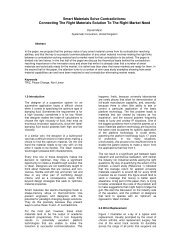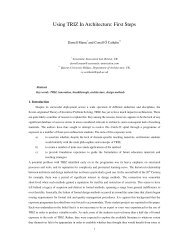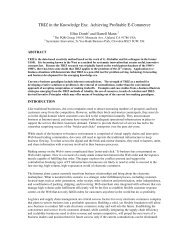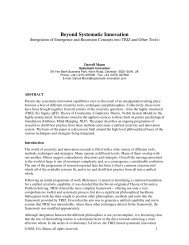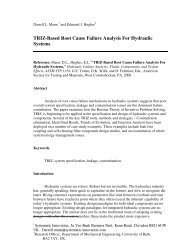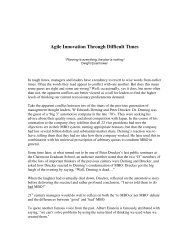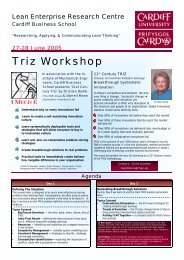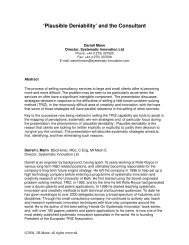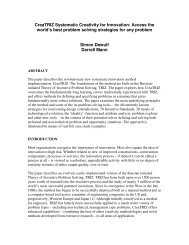systematic win-win problem solving in a business environment
systematic win-win problem solving in a business environment
systematic win-win problem solving in a business environment
You also want an ePaper? Increase the reach of your titles
YUMPU automatically turns print PDFs into web optimized ePapers that Google loves.
us<strong>in</strong>ess performance by successfully challeng<strong>in</strong>g the prevail<strong>in</strong>g trade-offs and conflicts<br />
of their <strong>in</strong>dustry and ‘elim<strong>in</strong>at<strong>in</strong>g’ key contradictions their competitors assumed were<br />
<strong>in</strong>herent.<br />
Most leaders and managers are at least beg<strong>in</strong>n<strong>in</strong>g to recognize the <strong>in</strong>herent weaknesses of<br />
compromise-based th<strong>in</strong>k<strong>in</strong>g approaches. The idea of <strong>w<strong>in</strong></strong>-<strong>w<strong>in</strong></strong> solutions is, conceptually at<br />
least, highly appeal<strong>in</strong>g. The database of <strong>w<strong>in</strong></strong>-<strong>w<strong>in</strong></strong> solutions <strong>in</strong> the bus<strong>in</strong>ess <strong>environment</strong> is,<br />
however, sparse. It is also though highly reveal<strong>in</strong>g; <strong>w<strong>in</strong></strong>-<strong>w<strong>in</strong></strong> solutions pay enormous<br />
dividends <strong>in</strong> terms of bus<strong>in</strong>ess performance. Figure 1 illustrates three such examples<br />
taken from Reference 1 – one of the first published articles quantify<strong>in</strong>g the benefits of<br />
<strong>w<strong>in</strong></strong>-<strong>w<strong>in</strong></strong> approaches.<br />
Figure 1: Differences <strong>in</strong> Bus<strong>in</strong>ess Performance Between Contradiction-<br />
Breakers and Industry Average<br />
(%) Industry<br />
average<br />
growth ‘88-’95<br />
(%) Industry<br />
-leader growth<br />
<strong>in</strong> same period<br />
Securities<br />
Brokerage<br />
US Domestic<br />
Airl<strong>in</strong>es<br />
Home<br />
Improvement<br />
Retail<strong>in</strong>g<br />
90 520<br />
80 370<br />
40 1500<br />
In the bus<strong>in</strong>ess <strong>environment</strong>, <strong>w<strong>in</strong></strong>-<strong>w<strong>in</strong></strong> is commonly viewed from a ‘nice to have, but there<br />
is no method, so we can’t do it’ perspective. There is probably also a considerable<br />
element of condition<strong>in</strong>g to several millennia of either/or th<strong>in</strong>k<strong>in</strong>g systems. One of the<br />
basic tenets of the TRIZ (2, 3) is that ‘someone, somewhere has most likely already<br />
solved someth<strong>in</strong>g like your <strong>problem</strong>’. One of the key elements of the TRIZ philosophy is<br />
that different discipl<strong>in</strong>es don’t talk to each other, and consequently much re-<strong>in</strong>vent<strong>in</strong>g of<br />
wheels takes place. Another key f<strong>in</strong>d<strong>in</strong>g of TRIZ – via the analysis of a considerable<br />
proportion of the world’s most successful eng<strong>in</strong>eer<strong>in</strong>g solutions – is that the most<br />
effective solutions occur when a <strong>problem</strong> solver has identified and ‘elim<strong>in</strong>ated’ a<br />
contradiction rather than accept<strong>in</strong>g the trade-offs their prevail<strong>in</strong>g contemporaries have<br />
taken to be <strong>in</strong>herent. The net result of this patent analysis is that there are – so far at least<br />
– just 40 different strategies available to help <strong>in</strong> this process of contradiction elim<strong>in</strong>ation.<br />
Subsequent research has thus far confirmed that it is precisely the same 40 strategies that<br />
are be<strong>in</strong>g used <strong>in</strong> achiev<strong>in</strong>g successful contradiction-break<strong>in</strong>g, <strong>w<strong>in</strong></strong>-<strong>w<strong>in</strong></strong> solutions <strong>in</strong> a<br />
bus<strong>in</strong>ess context (4).<br />
We explore here the codification of these strategies <strong>in</strong> their bus<strong>in</strong>ess context and the<br />
construction of tools to help <strong>problem</strong>, conflict or opportunity owners achieve <strong>w<strong>in</strong></strong>-<strong>w<strong>in</strong></strong><br />
outcomes <strong>in</strong> <strong>systematic</strong>ally reproducible manners.



